Fulfillment by Amazon (FBA) is a third-party logistics (3PL) company that provides multichannel order fulfillment services geared toward Amazon sales. In our review of the best order fulfillment companies for small businesses, Fulfillment by Amazon (FBA) scored 3.54 out of 5 based on pricing, functionality, specialty services, and ease of use.
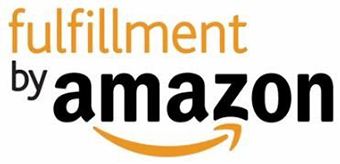
Pros
- Prime designation for all orders with fast shipping
- Boosted Amazon search rankings
- Integrated post-sale servicing and refund management
Cons
- Frequent pricing fluctuations and increases
- Strict packaging and labeling requirements
- Undisclosed accuracy rate with frequent errors reported
When to Use FBA
- Amazon sellers: FBA ensures all orders are eligible for Prime, helps improve search engine visibility, and raises the likelihood of winning the ‘Buy Box’ when the same products are listed by multiple sellers.
- Direct-to-consumer (DTC) brands: It has the infrastructure to optimize transit times, shipping costs, and global expansion.
- Inexpensive, small, and lightweight products: FBA’s pricing structure favors manageable, easy-to-ship goods, and it awards fulfillment discounts on items priced under $10.
When to Use an Alternative
- Multichannel sellers: FBA is compatible with multichannel sales but is not cost-effective unless Amazon is your primary marketplace.
- High-value, heavy, fragile, or oversized products: Red Stag Fulfillment is more economical for special-handling needs, and is Seller-Fulfilled Prime (SFP)-eligible.
- Sellers seeking high levels of control: Saltbox offers a better balance between in-house and outsourced order fulfillment that allows for customizations and control over your orders and inventory, unlike FBA.
- Sellers considering other online marketplaces: Flexport’s fulfillment service is highly similar to FBA, but specializes in helping you sell on other competitive marketplaces (such as Walmart, Wish, eBay, and others).
FBA’s third-party fulfillment services are best for Amazon-based sellers, ecommerce retailers, and brick-and-mortar stores looking to venture into online selling. Its vast network of 175 warehouses creates efficient global sales distribution, plus every FBA order is Prime-eligible.
There’s no minimum order volume required to use FBA (making it accessible to startups), and it’s most economical for sellers dealing in small, lightweight goods. With its stringent requirements, myriad fees, and associated risks, the service isn’t ideal for every business or product—especially those that require special handling or customizations.
Our Fulfillment by Amazon review finds it isn’t cost-effective for oversized or heavy products. Though the company has climate control in some of its warehouses, it’s not guaranteed that your temperature-sensitive goods will be stored in the right environment. Furthermore, FBA’s pricey multichannel order fulfillment and shipping fees aren’t economical unless Amazon is your primary marketplace.
FBA Deciding Factors | |
|---|---|
Supported Business Types | Small to midsize businesses, startups, ecommerce stores, retail stores, DTC sellers, B2B sellers, artisanal/handmade goods, subscription services |
Standout Features |
|
Minimum Order Requirements | None |
Setup and Onboarding Fees | None (onboarding and account setup are free, but monthly seller fees will incur) |
Pricing |
|
Contract Length | None |
US Warehouse Locations | 110 |
International Warehouse Locations | 65+ |
Shipping Partner Options | Amazon Logistics, UPS |
Customer Support | Via phone, email, and live chat 24/7 (support not available on-demand) |
How FBA Works

FBA uses Amazon’s vast infrastructure to streamline the fulfillment process, focusing on speed and customer experience. Here’s a deeper look at the steps of the process:
Once you’re an Amazon seller, the first step in using its fulfillment services is registering your products with FBA. Once logged and approved, you can send your inventory to an Amazon fulfillment center on a shipping pallet or through a freight forwarding company directly from your supplier.
Alternatively, a service like ShipBob can prep and send your inbound FBA shipments for you. Once received, the merchandise can be further distributed across FBA’s warehouse network to optimize logistics.
You need to pay an inventory storage fee to store your products in an Amazon fulfillment center. These fees depend on the size of your items and the time they’re stored. Amazon FBA storage fees start at 56 cents/cubic foot during off-peak season.
Did you know? To streamline distribution, FBA implemented inventory commingling—the grouping of identical products from different sellers in its warehouse facilities. Sellers see this as a potential risk because goods another retailer stores through FBA could be sent to a customer who purchased from your listing.
Once a customer places an order on Amazon or another sales channel, FBA picks, packs, and ships the merchandise. Fulfillment fees apply, starting at $2.45/unit for small, low-price items and going up to $200+ per unit for special, oversized products (like hot tubs and deep freezers). The charge includes labor, shipping costs, and packing materials.
Products in certain categories, namely clothing and accessories, are subject to greater fulfillment fees.
For many post-sale interactions (such as customer assistance, order returns, or refunds), FBA handles these processes on behalf of the seller. The company’s team of representatives is available to customers 24/7 through multiple communication channels. Returns are handled, discarded, and/or restocked to your specifications, and the platform manages refund payments.
FBA Alternatives
Aside from FBA, sellers have several alternative options for fulfilling their Amazon orders:
Fulfillment by Merchant (FBM)
Fulfillment by Merchant involves fulfilling your Amazon orders from your own in-house facility or another 3PL without claiming the Prime designation. There are fewer restrictions on shipping methods, delivery speed, and customization options than with other fulfillment options.
That said, FBM products are less likely to win the ‘Buy Box’ or rank higher in search results compared to similar listings fulfilled through FBA (Fulfillment by Amazon).
Seller-fulfilled Prime (SFP)
Seller-fulfilled Prime allows sellers to fulfill their own orders while still qualifying for Amazon Prime status. Fulfillment can be performed in-house or outsourced to a 3PL, but this option requires following Amazon’s Prime shipping rules, including same-day dispatch and two-day delivery. It offers greater control over inventory and shipping processes compared to FBA. SFP is ideal for sellers capable of meeting Prime’s delivery commitments while managing their own fulfillment logistics.
Alternative Fulfillment Companies
We recommend these order fulfillment companies as Fulfillment by Amazon alternatives:
Monthly Minimums | Best for | Review | Seller-fulfilled Prime (SFP) Eligible | |
|---|---|---|---|---|
 | $275 in usage | DTC and B2B ecommerce fulfillment | ✕ (FBA prep services available) | |
 | None | On-demand services, labor, and space for scaling in-house fulfillment | ✓ | |
 | $250 in pick and pack fees | Multichannel sellers seeking Seller-fulfilled Prime (SFP) fulfillment | No Review Yet | ✓ |
 | ≈200 orders | Oversized, heavy, high-value, or fragile items | ✓ | |
Fulfillment by Amazon Pricing
For this category, we evaluated based on pricing transparency, billing transparency, and billing predictability since many fulfillment companies offer pricing on a custom-quote basis.
FBA pricing is highly transparent, and all bills are visible by line item from its online portal. However, its complex order fulfillment pricing structure, frequent rate changes, and annually fluctuating fees result in poor predictability.
In The News: FTC Sues Amazon for Illegally Maintaining Monopoly Power
The FTC, along with 17 state attorneys general, have filed a lawsuit against Amazon for monopolistic practices. A major focus of it is Amazon’s requirement for sellers to use FBA to gain Prime eligibility. This mandate increases sellers’ costs on Amazon and limits their ability to sell on other platforms, effectively restricting competition against Amazon in the online marketplace.
Current FBA Pricing
As of 2023, Amazon has changed its rates. Below is the most up-to-date Fulfillment by Amazon pricing:
Service | Non-peak Season Cost | Peak Season Cost | What It Covers |
|---|---|---|---|
Onboarding | $0 | $0 | Onboarding and account setup are free, but monthly seller fees will incur |
Receiving | $0 when guidelines are met | $0 when guidelines are met | Inbound stock receipt, unpack, and check-in |
Inventory Storage | 56 cents–87 cents per cubic foot/month (Jan–Sept) | $1.40–$2.40 per cubic foot/month during (Oct–Dec) | Short-term storage with climate control and security options |
Fulfillment | $3.22 to $12.61 per unit for standard-size products $18.13 to $200+ for oversize products (Oct 15–Jan 14) | $3.42 to $13.11 per unit for standard-size products $19.13 to $200+ for oversize products (Jan 15–Oct 14) | Picking items from inventory, packing, packaging materials, shipping, and customer service |
FBA pricing changes periodically and fluctuates throughout the year, and other fees beyond these core charges may apply in certain circumstances. It’s important to thoroughly read the company’s policies and fee guides, and use Amazon’s calculator tools to see just how profitable it will be for you.
2024 Fulfillment by Amazon Pricing Changes
Throughout 2024, FBA is restructuring its pricing by introducing new fees, raising some existing ones, and lowering others.
Here’s a look at the Fulfillment by Amazon pricing changes to expect:
- Effective January 2024: Referral fees will decrease from 17% to 5% for apparel priced under $15 and from 17% to 10% for apparel under $15-$20.
- Effective February 2024: Fulfillment fee discounts ranging from 4 cents to $1.32 per item will apply to products shipped in their own packaging through the Ships in Product Packaging program.
- Effective March 2024: A new inbound placement service fee will be added, averaging 27 cents per unit for standard items and $1.58 per unit for large, bulky items. Sellers can reduce or eliminate this charge by distributing their inventory across multiple warehouse locations.
- Effective April 2024:
- Fulfillment fees will decrease on average by 20 cents per unit for standard items and 61 cents per unit for large items.
- A low-inventory-level fee will be introduced for standard items when a seller’s inventory levels are consistently low relative to sales.
- Non-peak storage fees will drop by an average of 9 cents per cubic foot/month for standard items.
- Effective June 2024: An additional returns processing fee will be applied to high return-rate products across all categories except apparel and shoes. This fee will target only those products with the highest return rates in their respective categories.
Selling on Amazon comes at a cost, regardless of how you fulfill your orders.
A professional seller account is $39.99 monthly, or individual sellers can pay 99 cents per item sold.
Referral Fees
You’ll also have a referral fee taken out of your account each time an item is sold on the platform. This fee is assessed as a flat percentage of the product price and ranges from 8% to 20% (with the exception of Amazon Device Accessories, which incur a 45% referral fee). Most items on Amazon have a 15% referral fee. See Amazon’s website for more info.
You’ll cover the cost of shipping your merchandise to FBA, which varies depending on the shipment’s origin and attributes. Amazon has negotiated shipping discounts through its partnered carriers.
FBA’s fulfillment fees cover the entire picking, packing, and shipping process, including outer packaging materials and delivery. These per-item fees start at $2.45 and can exceed $200 for special oversized items. The total of this charge considers many factors, including:
- Size
- Weight
- Quantity
- Category (such as apparel vs non-apparel)
- Price
- Sales channel
- Shipping speed (for multichannel orders)
During the peak holiday season (Oct 15–Jan 14), FBA charges slightly higher fulfillment fees for all categories except ‘Low-Price FBA’ items.
In The News: Low-Price FBA rates replace Small and Light
Fulfillment by Amazon has introduced the ‘Low-Price FBA’ program, offering reduced fulfillment fees for products priced under $10, while maintaining the same fast shipping as standard FBA items. On average, these rates are 70 cents lower than typical FBA fees.
This program replaced the previous ‘Small and Light’ program. Eligible sellers now pay an average of 30 cents more per item, but benefit from expedited shipping.
FBA’s base fulfillment fees are outlined below:
FBA charges a removal fee if you want to pull inventory from Amazon and/or dispose of unsold stock. The cost of this service is determined by weight and size tier and ranges from 70 cents to $13.05+.
It’s worth noting that many sellers have had issues with delayed stock removal, meaning their inventory has stayed in FBA’s warehouses for weeks or even months after they paid for and requested its removal. This problem incurs unexpected storage costs and reduced revenue for those affected.
Amazon has strict barcode label specifications for all stock received by FBA. You may be assessed a labeling fee of 55 cents per unit if items are not labeled properly.
FBA has stringent product packaging and prep guidelines. To avoid handling them yourself, you can opt to have Amazon pack and prep your products upon inbound receiving for a fee.
If you don’t opt into FBA’s prep service in advance, you’ll incur an unplanned prep fee for sending improperly prepared products. These charges vary by product and service type and range from 50 cents–$2.55 per unit.
The cost of a potential return is included in the fulfillment fee for most items, but goods in certain categories (such as apparel and accessories) don’t qualify for this service. FBA bills a return processing fee for those particular products equal to the original fulfillment fee. If the returned products need repackaging for resale, Amazon charges an additional repackaging fee.
The cost of storing your products at an FBA warehouse varies by season, increasing up to 200% during the October to December timeframe. The assessed cost also depends on the size of the product and whether it falls into the “dangerous goods” category.
Products that fall into FBA’s “dangerous goods” category—which includes items such as laptops, smartphones, household cleaners, spray paints, and cosmetics—incur higher storage costs. Read about FBA’s Dangerous Goods Program to learn more.
FBA Storage Fees by Season
Non-dangerous goods products | ||
Month | Standard-size | Oversize |
January–September | 87 cents per cubic foot | 56 cents per cubic foot |
October–December | $2.40 per cubic foot | $1.40 per cubic foot |
Dangerous goods products | ||
Month | Standard-size | Oversize |
January–September | 99 cents per cubic foot | 78 cents per cubic foot |
October–December | $3.63 per cubic foot | $2.43 per cubic foot |
As shown in the table above, Amazon FBA fees increase dramatically during the peak holiday season. This is something to watch if you use FBA, and it’s a significant reason that volume sellers rarely use FBA as their sole storage option.
Instead, power sellers often store the bulk of their inventory in cheap storage units or a company warehouse. Then, they periodically ship just enough stock to FBA to cover forecasted sales.
Long-term Storage Fees
For inventory held at an FBA warehouse longer than 270 days, sellers incur long-term storage fees. Between 271 and 365 days of storage, an additional $1.50 per cubic foot may be added to your fees. Beyond 365 days of storage, an additional 15 cents per unit may be tacked on, or your costs will increase to $6.90 per cubic foot (whichever is greater.)
Though Amazon doesn’t provide these, downloadable tools such as Sellics, InventoryLab, and Jungle Scout exist to make selling with FBA easier (and more profitable). These apps boost your marketing, inventory management, and reporting capabilities by integrating with your Amazon account. Third-party tools like these can incur up to $100+ per month, so it’s important to factor them in when calculating your outlay.
Examples of FBA Fulfillment Fees
T-shirt 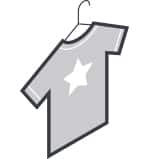 Size category: Large standard (Apparel) Dimensions: 14" x 10" x 0.76" | Baby cot 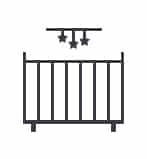 Size category: Small oversize Dimensions: 24" x 7.5" x 6" | Television  Size category: Large oversize Dimensions: 54" x 35" x 3.5" |
12.32 oz shipping weight | 7.9 lb shipping weight | 41 lb shipping weight |
Non-peak: $5.32/unit Holiday peak: $5.62/unit | Non-peak: $12.97/unit Holiday peak: $13.67/unit | Non-peak: $89.98/unit Holiday peak: $89.98/unit |
Image source: Amazon
These fees—combined with other Amazon charges—are often more expensive than the cost of hiring another SFP (Seller-Fulfilled Prime)-eligible fulfillment provider such as Red Stag or ShipMonk. But, for many Amazon-focused sellers, the steep costs are worth it for the advantages that FBA provides. Plus, you’re paying for FBA’s end-to-end services—which is more convenient on your part.
Additionally, buyers know what to expect regarding customer service because they’re dealing directly with Amazon. Outsourced, 24/7 customer service is a hefty investment when sought elsewhere, so it’s an important consideration for FBA costs. This especially applies to sellers dealing in goods with a naturally high return rate, like electronics or apparel.
FBA Quality & Functionality
Unlike many high-quality fulfillment services, FBA doesn’t disclose its accuracy rate, and the service is known among sellers and shoppers alike for its frequent errors. This cost the company points in this category—along with its lack of shipping partner options, limited pre-built integrations, and pricey multichannel fulfillment fees.
That being said, FBA provides fast turnaround times and a wide warehouse network that trump competing services.
Click below to expand on the features that contribute to FBA’s score.
If you use sales channels other than Amazon (such as your own Shopify store and/or other online marketplaces like eBay) you can use FBA to fill those orders, too. Amazon calls this service Multi-Channel Fulfillment, or MCF.
For multichannel FBA users, inventory storage fees remain the same, but MCF fulfillment fees are higher. MCF orders don’t incur an added Amazon seller fee.
The MCF fee accounts for the entire process of picking items from inventory, packing, and shipping. But, Amazon does not handle post-sales servicing for MCF orders. Thus, you’ll need to field all multichannel customer inquiries, returns, and refunds yourself (or hire employees to do so).
With most MCF orders, you can select between three shipping methods: Standard, Expedited Two-Day, and Priority One-Day. This is helpful if you offer a range of shipping options on your own ecommerce store or website. Also note that if an MCF order contains multiple units, the cost per unit decreases.
If you compare Amazon’s MCF fees to the shipping rates you’d pay to fulfill orders yourself, you’ll likely find MCF is a pretty good deal. While this is the case, multichannel sellers who don’t focus mainly on Amazon sales are better off partnering with a cheaper 3PL, such as ShipBob.
Amazon has 110 FBA warehouses strategically located across the continental US (see the full list of warehouse locations below)—plus more than 65 additional fulfillment centers worldwide.
This allows sellers to split inventory across multiple warehouses, keeping products in close proximity to multiple customer bases. FBA’s large warehouse network also simplifies inbound shipping and importing by enabling merchants to use warehouses close to their suppliers or ports of destination.
To compare with competing fulfillment companies, ShipMonk has a total of 10 warehouse locations, and Red Stag has just two. It’s rare to find a small business-friendly 3PL company with infrastructure as vast as FBA.
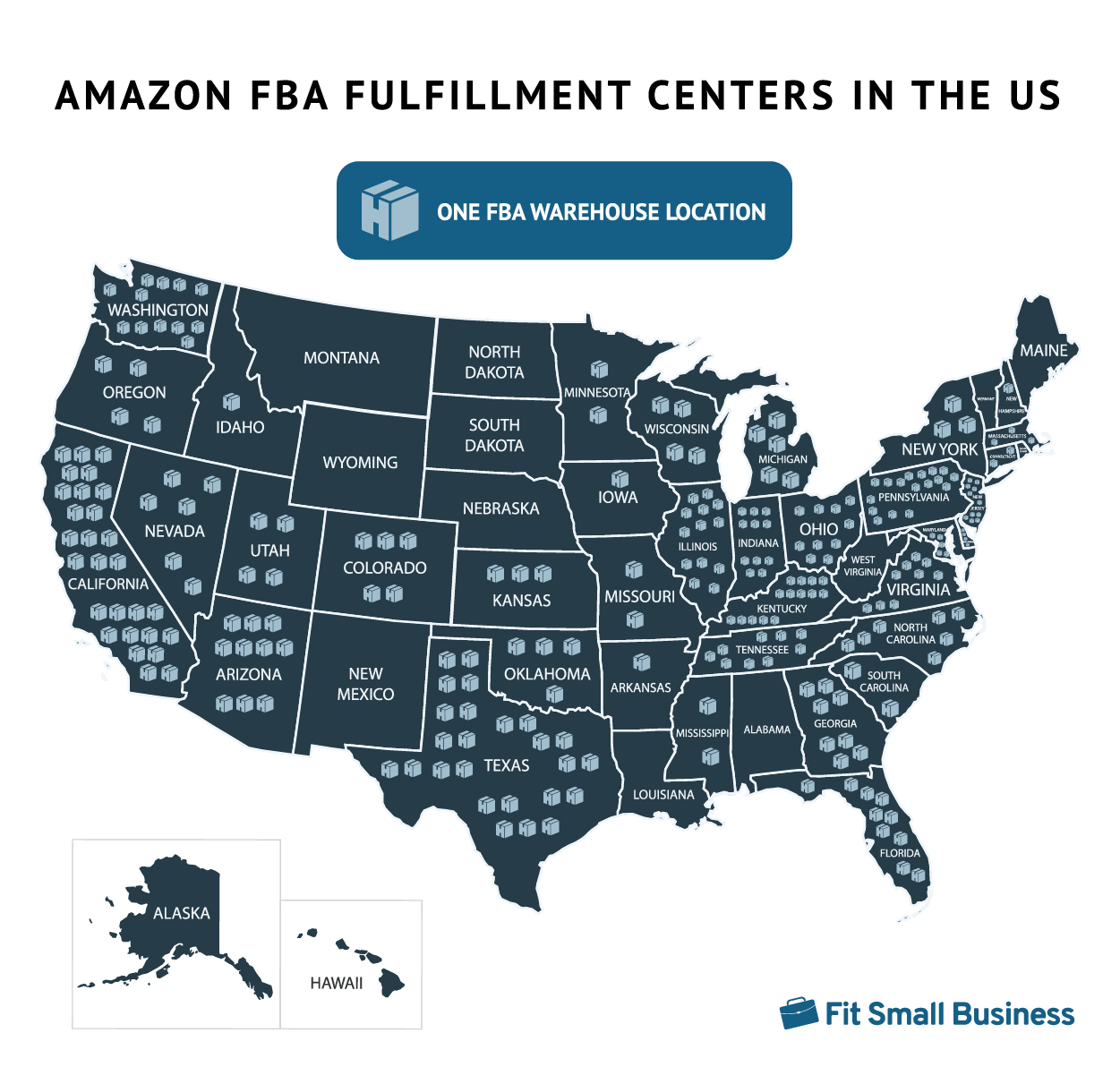
A map of Amazon’s US fulfillment facilities
Amazon’s Seller Support team serves FBA users in addition to all other Amazon sellers. While Amazon customer service is highly responsive and effective for shoppers, Seller Support is notoriously unreliable—reportedly leaving users waiting multiple weeks or even months for issue resolution. It’s also reported that most Seller Support is outsourced to third-party representatives with insufficient training.
If you search for Seller Support contact info online, you’ll come across a phone number that’s actually reserved for Amazon customers. The only way to contact Seller Support is by filling out a ticket and requesting a call or email.
It’s not uncommon for fulfillment companies to structure their support this way; when response time is fast, a lack of on-demand customer service is typically a non-issue. But, FBA’s response time is reportedly very slow, and some users state that it requires multiple follow-up requests in order to speak with someone.
In addition to Seller Support, a seller community forum and online knowledge base are available for users to troubleshoot on their own.
FBA’s native integrations are very limited compared to other top order fulfillment companies. But, thanks to its open APIs and enormous popularity, thousands of FBA integrations are readily available through third-party developers.
Plus, FBA directly integrates with certain ecommerce integration service providers, such as WebBee. This makes it possible to integrate with any of your necessary tools or platforms quickly and easily—though it may come at an additional cost.
Other companies, such as Zapier, have created numerous plug-and-play integrations to connect FBA and Amazon Seller Central to a host of other apps and programs you may use.
Suppose you’re unable to find your desired integration pre-made. In that case, FBA’s developer-friendly APIs make it easy to create a custom-made connection. However, unlike other fulfillment partners such as ShipBob and Red Stag, FBA does not offer integration development as a value-add service.
Here’s a list of FBA’s current proprietary direct integrations:
- Ecommerce platforms and marketplaces: WooCommerce, VTEX, 3dcart, Shopify, WebBee, and Bytestand
- Freight and shipping solutions: AfterShip
- Operations, inventory, and order management: ChannelAdvisor, Listing Mirror, Orderhive, Zentail, Skubana, Sellbrite, and Sellercloud
FBA Specialty Services
Aside from the standard features of fulfillment, warehousing, and distribution, FBA provides a host of advantages that can help your Amazon business succeed.
FBA’s specialty services include:
One of the most popular features of FBA is the free Prime shipping for Amazon Prime subscribers. Some products are eligible for free shipping, even if a buyer isn’t a Prime member. However, it might take longer for the package to arrive for non-members.
FBA product listings prominently feature the Amazon Prime logo, signaling to Prime members they can purchase your product with free Prime two-day shipping or other Prime offers. Prime boasts about 200 million subscribers who look for the Prime logo while shopping—so FBA products attract far more buyers than non-Prime products.
Amazon provides free shipping for all customers, Prime members or not, on orders over $35, but only for eligible products, which include FBA items. This also extends to Amazon coupon deals and special events like Prime Day and Cyber Days, where FBA products are also eligible for these promotions
In addition to the standard order fulfillment processes, FBA performs customer service-related tasks for your Amazon orders. The company’s well-established CS team is available 24/7 by phone, email, or live chat on the app or website and has a reputation for providing highly accommodating support.
The cost of outsourcing this level of service elsewhere would be astronomical. For each hired representative, call center outsourcing in the US can cost anywhere from $25 to $65 per hour. To have just one employee on call for these hours would cost thousands of dollars each month—and potentially hundreds of thousands each year. In that regard, FBA is incredibly cost-effective.
FBA listings get a significant edge over non-FBA items in Amazon’s search engine algorithm. This leads to higher rankings for FBA products in Amazon’s product search results, helping achieve more sales.
Another advantage is prioritization in Amazon’s Buy Box, which is the “Add to Cart” button on most product listings. When viewing a product sold by multiple sellers, hitting this button will add one chosen listing to the customer’s cart.
The platform selects which listing gets to “own the Buy Box” using an algorithm that considers price, shipping speed, seller metrics, and fulfillment method. One of the most heavily weighted factors in determining Buy Box ownership is the use of FBA.
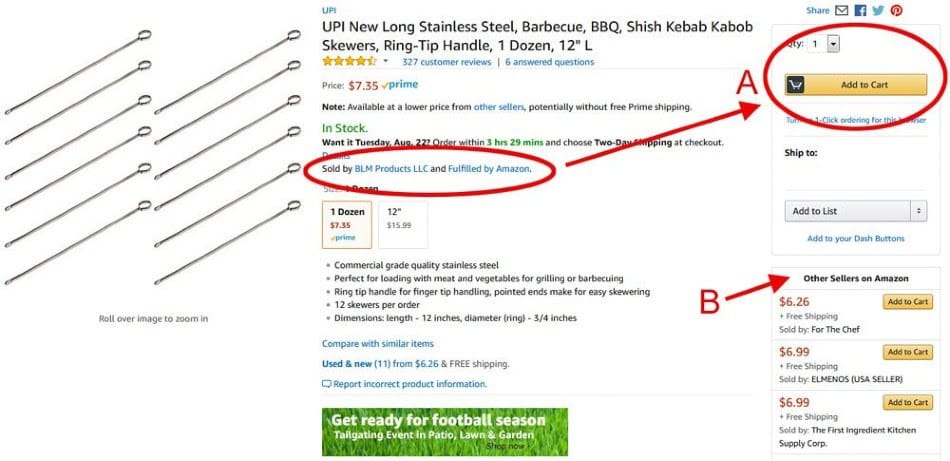
The Buy Box (A) is a coveted position for Amazon sellers, as it’s the default choice when customers click “Add to Cart.” In a price tie, FBA Prime-eligible products often get priority, and can sometimes win the Buy Box even over lower-priced non-FBA products (B).
Amazon’s Subscribe & Save feature offers customers discounts and free shipping for subscribing to recurring, automated product purchases. This gives customers a convenient, regular delivery at their chosen interval and helps sellers obtain repeat customers. It’s one of the best ways to have consistent revenue with Amazon, and is only available to sellers using FBA.
It doesn’t cost sellers to offer the Subscribe & Save feature. However, merchants must meet minimum requirements (such as a feedback rating of 4.7 or higher) and maintain good standing with the platform. The feature is only available to sellers using FBA for three months or more.
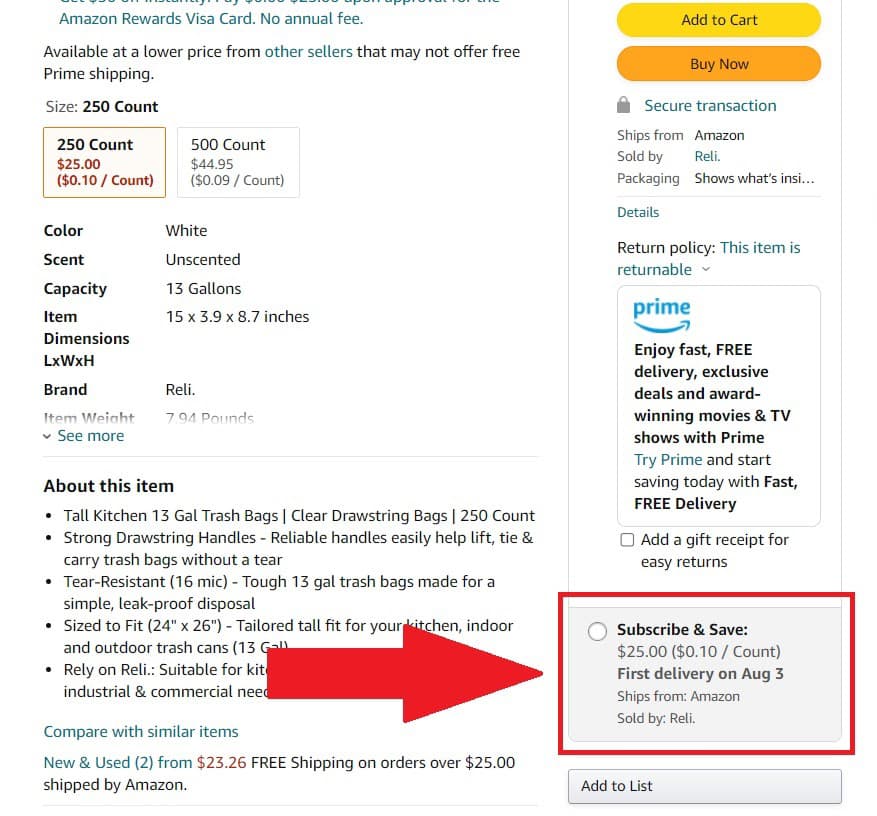
The Subscribe & Save buying option can be offered to customers on your FBA listings as a conveniently scheduled purchase.
FBA Ease of Use
FBA earned points for its 24/7 customer support hours, high scalability, and lack of minimum order volume requirements. We docked points for FBA’s low operational transparency and fulfillment software (which isn’t as sophisticated or user-friendly as that of competing providers).
Here’s a summary of the factors we considered:
- Onboarding: Unlike many fulfillment companies in its class, FBA doesn’t provide support to assist with onboarding and migration. Users report that this creates a sizable learning curve.
- Accuracy: FBA doesn’t disclose its accuracy rate, and errors are frequently reported. For comparison, ShipBob, ShipMonk, and Red Stag maintain an accuracy rate of 99.95% or higher.
- Error Policies: If an item you send to FBA is lost or damaged on behalf of Amazon, the company will replace that item with an identical one or reimburse you for it. This sometimes happens automatically, but you’ll need to submit a claim in many instances. There are multiple processes for filing a claim depending on where your product was in the fulfillment process when it was lost or damaged.
- Customer Service: Customer service for FBA is available 24 hours a day, seven days per week. Support is not on-demand, so clients must submit a ticket and request a call or email. The service is reviewed poorly by its users.
- Transparency: FBA provides lackluster operational transparency, making it difficult for sellers to accurately see their stock levels or track an order through the fulfillment process.
- Scalability: With more than 150 million square feet of warehouse space and 1.6 million employees worldwide, Fulfillment by Amazon boasts a massive infrastructure most retailers can’t outgrow. It also supports B2B transactions through Amazon Business.
FBA Expert Score
Overall, we like FBA for its ability to give Amazon sellers the competitive edge needed to succeed on the platform. It provides a decent value for your money and an array of unique services, but FBA’s popularity and ease of use leave room for improvement.
FBA User Reviews
There aren’t many Fulfillment By Amazon reviews or ratings available online, and much of the scrutiny you will find is of the entire Amazon marketplace platform (rather than FBA itself).
Amazon Services Seller Forums is a great place to get insight into what it’s like to use FBA as an online merchant. Since it’s mainly a resource for solutions, assistance, and discourse rather than ratings and reviews, the posts are not reflective of the benefits of FBA. But, the questions and discussions posed by FBA users are highly valuable.
In reviews, forum posts, and comments alike, users report complications due to FBA’s labeling protocol, lost items and shipments, and difficulty with Amazon’s Seller Support. Much of this likely ties into FBA’s error rate, which is undisclosed, unlike nearly every other fulfillment provider.
When many sellers leave a positive Fulfillment by Amazon review, they mention benefitting from the company’s fast shipping and outsourced customer service. Many describe the relationship as “simple” and “hassle-free,” but even 5-star reviews mention the high cost of the convenience that FBA provides.
- G2: 4.5-star rating from about 10+ Fulfillment by Amazon reviews
- WarehousingAndFulfillment.com’s FBA review
| Users Like: | Users Don’t Like: |
|---|---|
| Hassle-free, end-to-end outsourced services | Fluctuations in fees and product categorization |
| Fast shipping | Lost merchandise and shipments |
| Efficient warehouse services and turnaround time | Ineffective client support |
| Improved customer experience | Complex restrictions and regulations |
| Saves time | Expensive fees |
FBA Warehouse Locations
Click the interactive state directory map below to see FBA warehouse locations per state.
How We Evaluated Fulfillment by Amazon (FBA)
In our evaluation of Fulfillment by Amazon and other fulfillment providers, we weighed them against a 23-point scale based on pricing, functionality, specialty services, and ease of use. Our team of retail and ecommerce experts also weighed in and evaluated each service based on our industry experience.
Click through to see the scoring criteria:
20% of Overall Score
30% of Overall Score
Fulfillment by Amazon received a moderate score in this area, primarily due to limited shipping partner choices and an undisclosed accuracy rate, alongside frequent reports of operational errors.
15% of Overall Score
FBA was docked for its lack of standard services like custom outer packaging and kitting/assembly, but earned points for its robust Amazon-focused specialty services.
15% of Overall Score
We also evaluated software usability and operational transparency, rewarding companies with functional software that tracks order status and warehouse space. Additionally, we heavily weighed order minimums and scalability, aiming to recommend services that can grow with small businesses.
20% of Overall Score
Frequently Asked Questions (FAQs)
Here are some common questions we encounter about Fulfillment by Amazon.
FBA is a service for Amazon-focused businesses that sell physical products. You may be a good candidate for FBA if 80% or more of your sales come from Amazon, and your store processes more orders than you can—or want to—fulfill on your own.
The company specializes in DTC ecommerce sales, but also supports Amazon’s program for B2B sales.
FBA fees include costs associated with selling on Amazon. It consists of fulfillment, inventory, storage, labeling, and prep services fees—to name a few. Read our guide on Amazon seller fees to know the cost of selling on Amazon.
Using Fulfillment by Amazon (FBA) can be worth it for Amazon-focused sellers, offering significant and valuable benefits to boost Amazon sales. However, it is often critiqued for its complex pricing, high fees, steep storage costs, and challenges faced by multichannel sellers.
Bottom Line
Fulfilled by Amazon isn’t just about fulfillment. It’s about leveraging Amazon’s brand and the Prime loyalty program to boost your exposure and sales on the Amazon marketplace.
Our Fulfillment by Amazon review found that the company offers significant benefits and seamless order processing for Amazon sales, but it can be tricky. Sellers must diligently monitor their accumulating fees, inventory preparations, and standing with the platform. Additionally, it opens the door for fraud, such as counterfeit merchandise and listing hijacking, so sellers must also be wary of their reputation with customers.
Many factors play into your profitability with FBA—especially the size and weight of your goods. Be sure to calculate your anticipated FBA costs and consider other fulfillment providers. To compare your specific needs to 500+ pre-screened companies, try using a broker such as WarehousingAndFulfillment.com. It comes with a no-spam guarantee, and it’s completely free to use.